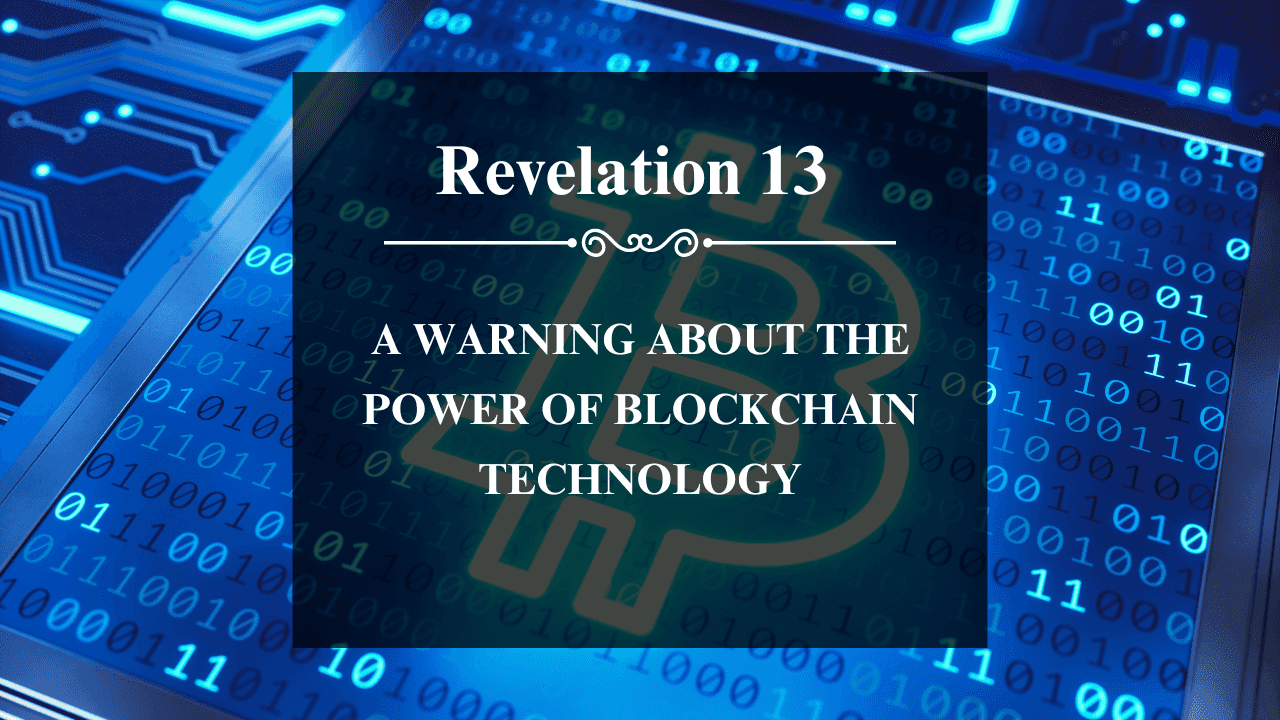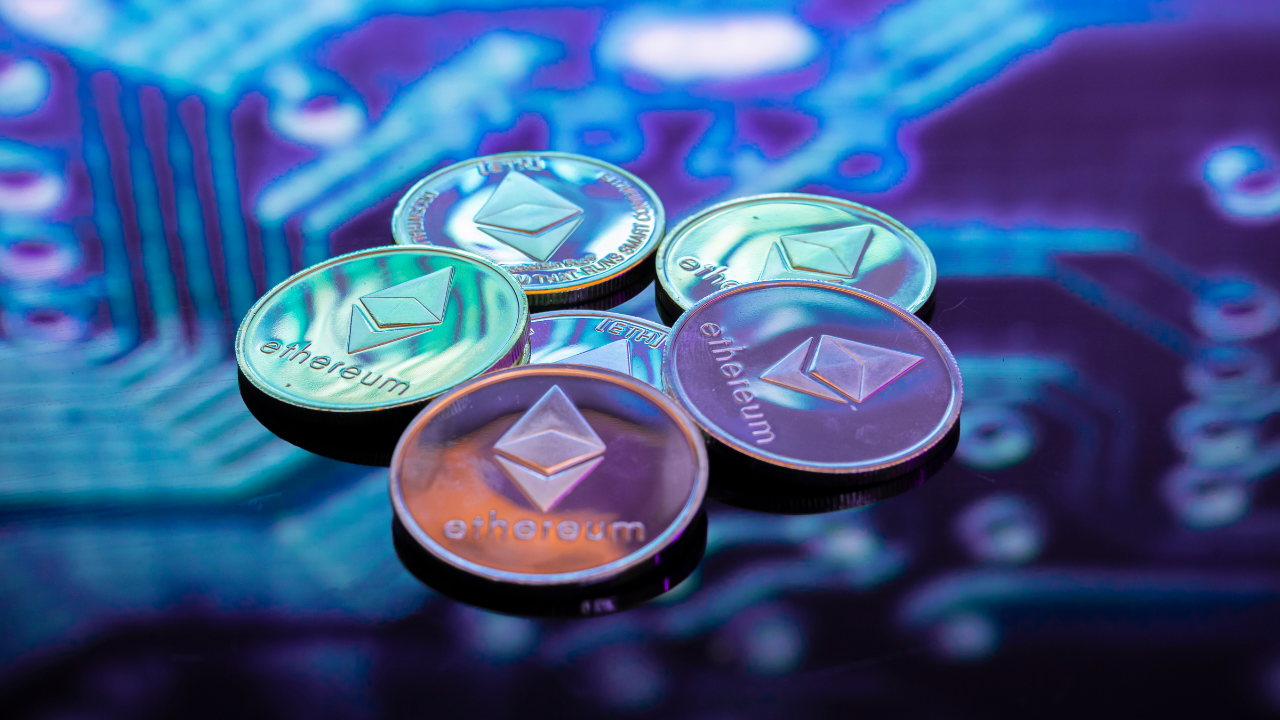
Is Revelation 13 a Warning About the Power of Blockchain Technology?
Prophecy14th of September, 2024
"The second beast was given power to give breath to the image of the first beast, so that the image could speak and cause all who refused to worship the image to be killed. It also forced all people, great and small, rich and poor, free and slave, to receive a mark on their right hands or on their foreheads, so that they could not buy or sell unless they had the mark, which is the name of the beast or the number of its name."
-Revelation 13: 16-17
Introduction
In our rapidly evolving digital landscape, discussions about technology often take on a life of their own, interweaving with cultural, philosophical, and even theological narratives. One area that has sparked significant debate is the emergence of blockchain technology—a decentralized ledger that has the potential to radically alter how we perceive trust, transactions, and governance. However, this discussion takes a provocative turn when we examine the implications of a centuries-old text: Revelation 13 in the New Testament.
Understanding Revelation 13
Revelation 13 is a chapter rich with symbolic imagery and eschatological significance. Often interpreted as a prophetic warning of an oppressive regime and a society characterized by control, this chapter introduces the so-called "Beast," which is commonly associated with tyranny, economic manipulation, and societal pressure to conform. The chapter concludes with a chilling mark, known as the "mark of the Beast," which allows individuals to buy or sell; without it, participation in the economy is impossible
For centuries, theologians and scholars have dissected these passages, each bringing their own interpretations and contextual understandings. As we dive deeper into the implications of blockchain technology, particularly the ways it could mirror—or even fulfill—the warnings laid out in Revelation 13, we can't help but reflect on its double-edged nature.
Blockchain’s Promise and Perils
At its core, blockchain technology encapsulates revolutionary ideals: decentralization, transparency, and security. It offers the potential for more equitable financial systems, enhanced privacy, and greater individual empowerment. By eliminating intermediaries and allowing peer-to-peer transactions, proponents argue that blockchain could democratize economic participation and dismantle traditional power structures.
However, this transformative technology is not without its risks. Increased reliance on digital systems can lead to vulnerabilities, particularly in terms of privacy and surveillance. The same features that promise to empower individuals could also be manipulated by authoritarian regimes to surveil, control, and ultimately oppress societies. Cryptocurrency, while heralded for potentially offering financial freedom, can also facilitate illicit activities and be exploited by those in power—echoing some fears found in Revelation 13.
The Mark of the Beast and Digital Identity
One of the most alarming aspects of the discussion surrounding blockchain and Revelation 13 is the idea of a "mark." While some interpret this mark as symbolic, others see parallels in modern concepts such as digital identity and government-issued identification tied to blockchain systems. As society moves toward digital currencies and blockchain-based identity solutions, the concept of needing to “prove” one’s identity to participate in economic activities becomes all too real.
In a world where transactions might require verification through a digital identity—perhaps even a blockchain-based mark—individuals may find themselves at the mercy of larger systems that dictate who can and cannot participate in the economy. This potential for exclusion echoes the warnings in Revelation 13, where the inability to obtain the mark leads to economic disenfranchisement.
Balancing Innovation with Vigilance
The challenge moving forward lies in finding a balance between harnessing the transformative power of blockchain technology and ensuring that it does not lead to the kind of system described in Revelation 13. As innovators and policymakers develop new applications of blockchain, it’s essential to keep ethical considerations at the forefront.
-
Privacy Protection: Emphasizing solutions that prioritize data protection can mitigate the risk of surveillance and control.
-
Decentralized Governance: Encouraging models that support democratic decision-making can help avoid concentration of power.
-
Inclusivity: Committing to systems that are accessible to all, including marginalized groups, is critical as we navigate this technological landscape.
Conclusion
As we continue to explore the implications of blockchain technology, its potential to empower or control society hangs in a delicate balance. While it may not be a direct fulfilment of biblical prophecy, Revelation 13 provides a thought-provoking lens through which we can examine the power dynamics that technology introduces. As we navigate this brave new world, let us remain vigilant and aware, seeking to forge a future where technology serves humanity rather than dominates it. The lessons from the past—both historical and theological—can serve as a guiding compass as we tread further into this uncharted territory.
The XRP Ledger: The Future of Value Transfer
In the ever-evolving landscape of blockchain technology and cryptocurrencies, the XRP ledger has emerged as a significant player that stands out from the crowd. Developed by Ripple Labs in 2012, XRP is not just another digital currency; it represents a strikingly innovative approach to value transfer and international payments. While there are many noteworthy aspects of the XRP blockchain, one revolutionary fact that truly sets it apart is its extraordinary ability to facilitate cross-border transactions at lightning speed and minimal cost.
Speed and Efficiency Redefined: Unlike traditional banking systems and even many cryptocurrency networks, XRP can settle transactions in just three to five seconds. This incredible speed arises from its unique consensus algorithm, which eliminates the need for extensive mining processes that other cryptocurrencies, like Bitcoin, rely on. In environments where time is a crucial factor—say, for businesses making international payments—this capability offers unprecedented efficiency.
Cost-Effectiveness: A Game Changer: In addition to being faster, XRP’s transaction costs are also remarkably low, typically amounting to a fraction of a cent. Traditional international money transfers often incur exorbitant fees due to intermediary banks and currency conversion costs. XRP solves this problem by providing a direct pathway between different currencies, significantly reducing transaction fees and making it an attractive option for banks, financial institutions, and businesses willing to explore innovative technological solutions.
Scalability: Ready for Mass Adoption: Another revolutionary fact about the XRP blockchain is its impressive scalability, capable of handling up to 1,500 transactions per second (TPS). This is essential for a global payment network, especially as the demand for digital payment solutions continues to grow. In contrast, Bitcoin’s network can handle about 3 to 7 TPS, which raises serious concerns about scalability for extensive use cases. XRP’s capacity not only makes it suitable for individual users, but also positions it as a compelling solution for institutional adoption.
Decentralization with Governance: While some critics often question the true decentralization of the XRP network due to Ripple Labs’ significant influence, it’s essential to recognize that XRP operates on a distributed ledger technology where all validators are independently run by various entities globally. This governance structure provides a balance between efficiency and decentralization, offering a level of transparency that is critical for building trust among users.
Focus on Financial Institutions: One particularly revolutionary element of the XRP blockchain is its strong focus on working with established financial institutions rather than competing against them. Ripple’s strategy includes partnerships with numerous banks and payment providers, solidifying its position as a bridge currency. This collaborative approach not only lends credibility to XRP but also accelerates its potential for mass adoption in the mainstream financial system.
Conclusion: A Transformative Force in Finance: In conclusion, the XRP blockchain is more than just a means of transferring value; it's a transformative force poised to redefine how we think about money, payments, and financial transactions on a global scale. With its remarkable speed, low cost, scalability, and collaborative focus on existing financial infrastructure, XRP stands out as a pioneering solution in the crowded cryptocurrency space. As we continue to move toward an increasingly digital economy, the revolutionary capabilities of the XRP blockchain are sure to play a critical role.
Embracing this technology may well be the key to unlocking a future where sending money across borders is as simple and fast as sending an email. The world is watching, and the time to recognize the potential of the XRP blockchain is now.
The Bitcoin Blockchain: A store for value.
The world of cryptocurrencies has been abuzz with discussions about blockchain technology since Bitcoin first appeared on the scene back in 2009. While many know Bitcoin as a digital currency, a revolutionary fact about its underlying blockchain technology is often overlooked: it acts as a robust public ledger that can enable decentralized trust across various sectors, not just finance. Let's explore this fact and its implications for the future of various industries.
The Essence of a Public Ledger
At the heart of Bitcoin's blockchain is a decentralized public ledger, which records every transaction made with Bitcoin. This ledger is distributed across a network of computers (nodes), making it transparent, immutable, and secure. Each transaction is timestamped and linked to the previous one, creating a chain of blocks—hence the term 'blockchain.'
What makes this ledger revolutionary is that it enables trust without the need for a central authority. Traditional systems rely on intermediaries—like banks, notaries, or clearinghouses—to validate transactions. These intermediaries introduce delays, costs, and vulnerabilities to fraud. In contrast, the Bitcoin blockchain eliminates the need for such intermediaries by providing transparency and security through cryptographic hashing and consensus mechanisms.
Decentralized Trust Redefined
This public ledger’s implications extend far beyond Bitcoin and finance; they are transforming how we think about trust in nearly every industry. With the promise of decentralization, we can envision a future where various sectors benefit from the revolutionary nature of the Bitcoin blockchain:
Supply Chain Management: Every step of a product's journey can be recorded on the blockchain, providing transparency and accountability. Companies can track the origin of materials, ensuring ethical sourcing and reducing fraud.
Voting Systems: By utilizing blockchain technology, voting can become a transparent, tamper-proof process. Every vote could be recorded on a public ledger, allowing for real-time verification and significantly reducing the risk of electoral fraud.
Digital Identity: The blockchain can provide individuals with a secure and verifiable digital identity, giving people more control over their personal information and reducing the risk of identity theft.
Intellectual Property: Artists and creators can use blockchain to record ownership and copyright information, allowing for clearer rights management and an instant way to track and monetize their work.
Healthcare: Patient records can be securely stored and shared on the blockchain, ensuring that they are accessible only to authorized users while maintaining privacy and data integrity.
Conclusion: The Road Ahead: The revolutionary nature of the Bitcoin blockchain lies in its ability to cultivate decentralized trust across various sectors, fundamentally challenging traditional systems built on central authority. As we continue to explore its potential beyond cryptocurrencies, the adoption of blockchain technology could lead to more efficient systems, reduced costs, increased transparency, and better security.
While there are still hurdles to overcome—such as scalability, regulatory frameworks, and public awareness—the transformative potential of blockchain technology is undeniable. The future isn’t just about Bitcoin as a currency; it's about the endless possibilities that come from a system that can bring trust to the digital age.
As we embrace this technology, let’s keep asking: how can we harness the power of decentralized trust to create a better world for all?
Ethereum VM: The Power of Smart Contracts and Non-Fungible Tokens
In recent years, Ethereum has emerged as a pivotal platform in the world of blockchain technology, paving the way for groundbreaking applications in various sectors. This blog post delves into two of the most significant innovations facilitated by Ethereum: smart contracts and non-fungible tokens (NFTs). Understanding these concepts opens the door to appreciating the transformative potential of blockchain technology.
What is Ethereum?
Ethereum is an open-source blockchain platform that enables developers to build and deploy decentralized applications (dApps). Launched in 2015 by Vitalik Buterin and a team of co-founders, Ethereum's primary goal was to create a programmable blockchain that allows developers to write code for applications beyond simple financial transactions.
One of Ethereum’s defining features is its built-in programming language, Solidity, which enables the creation of smart contracts—self-executing contracts with the terms of the agreement directly written into code. The Ethereum network is powered by its native cryptocurrency, Ether (ETH), which facilitates transactions and incentivizes miners and validators.
Smart Contracts: Revolutionizing Agreements
Smart contracts are arguably one of the most revolutionary features of the Ethereum platform. Unlike traditional contracts, which require intermediaries (like lawyers or notaries) for enforcement, smart contracts execute automatically when conditions are met. Here’s why they are game-changers:
Automation and Efficiency: Smart contracts eliminate the need for intermediaries, streamlining processes and reducing costs. Once a smart contract is deployed on the Ethereum blockchain, it operates automatically, ensuring that all parties receive what was agreed upon without delay or dispute.
Transparency and Security: Smart contracts are stored on a public blockchain, meaning all participants have access to the same data. Every transaction executed by the contract is recorded on the blockchain, making it immutable and secure against tampering or fraud. This level of transparency increases trust among parties involved in a contract.
Versatility: Smart contracts can be utilized in a multitude of sectors, including finance (decentralized finance or DeFi), supply chain, real estate, and gaming, among others. They allow complex transactions, such as multi-signature wallets, automated payments, and conditional sales, to be executed seamlessly.
Non-Fungible Tokens (NFTs): Unique Digital Assets While smart contracts facilitate various applications, one of the most innovative uses of Ethereum has been the creation of non-fungible tokens, or NFTs. Unlike traditional cryptocurrencies like Bitcoin and Ether, which are fungible (each coin is identical to another), NFTs represent unique digital assets. Here are some key points about NFTs:
Ownership and Provenance: NFTs use smart contracts to record ownership and provenance on the blockchain. This functionality allows artists, musicians, and creators to tokenize their unique works, guaranteeing authenticity and facilitating a direct connection between creators and consumers without the need for intermediaries.
Diverse Applications: The NFT space has exploded in popularity, encompassing various domains, including digital art, music, virtual real estate, collectibles, and gaming. Artists like Beeple and brands such as NBA Top Shot have showcased the power of NFTs, turning previously intangible digital creations into valuable assets.
Interoperability: NFTs on the Ethereum platform can interact with other dApps and platforms. This interoperability means that a digital art piece minted on Ethereum can be showcased in virtual galleries, sold through decentralized marketplaces, or integrated into games.
Challenges and Future Directions Despite the promising potential of smart contracts and NFTs, challenges exist. Scalability, high transaction fees, and environmental concerns associated with proof-of-work mechanisms have been topics of discussion. The Ethereum community is actively working on solutions, including Ethereum 2.0, which aims to transition the network to a more scalable and energy-efficient proof-of-stake model.
As the technology matures, we can expect further innovations in smart contracts and NFTs, ultimately reshaping various industries. The use of Ethereum for programmable contracts will likely expand, while the evolution of NFTs could lead to new models of ownership and value creation.
Conclusion Ethereum has opened the door to a new era of decentralization, innovation, and creativity through smart contracts and non-fungible tokens. By redefining how agreements are formed and how digital ownership is established, Ethereum is poised to shape the future of technology and finance. As we move forward, staying informed and engaged with these developments will be crucial in understanding the ongoing transformation of our digital landscape.


